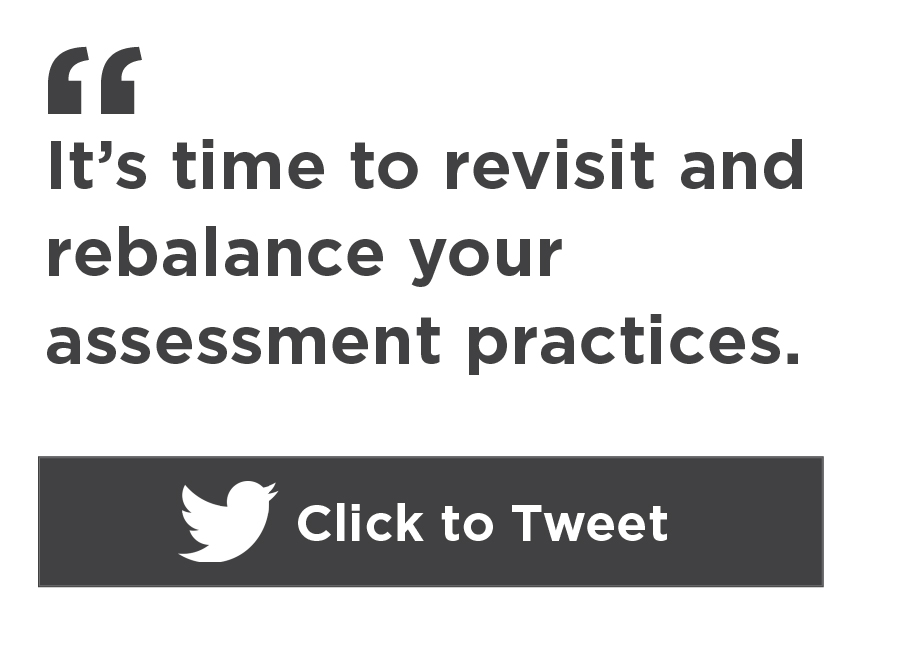There is a saying that schools can be data rich, but information poor. This means that you can have many sources of data on students but lack the coherent information you need to make effective decisions. It’s helpful to consult many sources of formal and informal data to inform your instructional design, of course, but without an intentional, well-thought-out plan for how all the sources of data fit together, it will be hard to make decisions well. A coherent approach to assessment practices can streamline decision-making and improve learning.
One way to achieve this coherence is by developing a balanced assessment system. A balanced assessment system intentionally makes use of formative, interim, and summative assessment practices—with the most emphasis placed on formative assessment. This type of system is at the heart of a Multi-Tiered System of Support (MTSS), which uses a decision-tree approach to assist in streamlining decisions, as shown below.
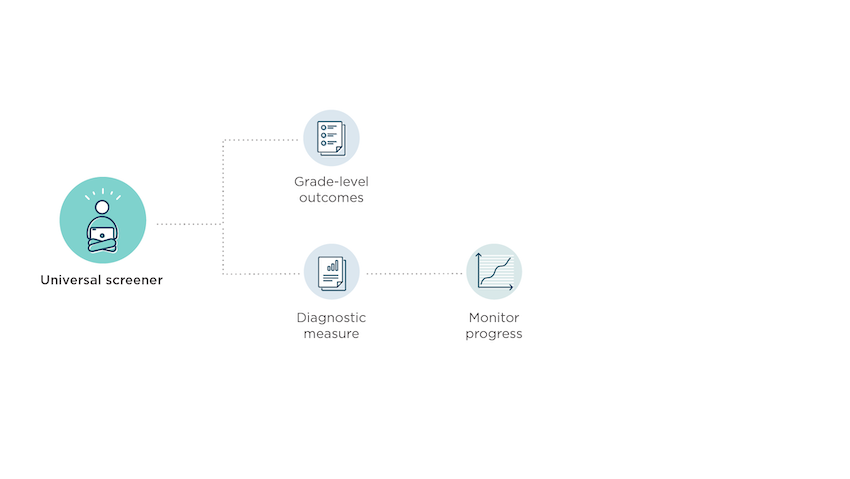
Strike a balance
To create a balanced assessment system, there are two major domains that teachers need to consider:
- The standards-based core instruction domain that aligns to grade-level or advanced content
- The intervention domain for students who are not yet achieving standards and need additional support
Formative assessment plays a key role in both domains and should always be the starting point. It begins as a universal screening process for all students. Universal screening can take many forms, such as an early literacy probe, behavioral data, attendance patterns, grades, and even MAP® Growth™ or MAP® Reading Fluency™. The purpose, just like when doctors take your blood pressure and weight during an annual checkup, is to look for signs that something might be off track. Following the administration of a universal screening process, educators face a decision point that affects which of the two domains come into focus for teaching and learning.
For students who are more or less on track with the universal screening measures, teachers should proceed with business as usual in the core instruction domain, using formative assessment practices to connect to and activate prior knowledge in ways that guide the relationship of teaching and learning, check for understanding along the way, and assess mastery against grade-level outcomes to determine if future adjustments need to be made.
This moment in time is an opportunity to revisit and rebalance your assessment practices. […] [A] balanced assessment system—built on formative assessment practices—can guide instruction to meet the needs of your students.
If the universal screener indicates that the learning or social-emotional well-being of a student is at risk, then the best course of action for teachers is to employ formative assessment practices that diagnose and pinpoint what support is needed within the intervention domain, monitor progress on a learning progression, and assess mastery of prerequisite learning.
How to move forward with core instruction
All students should experience teaching and learning that supports their success in the core instruction domain. This begins with teachers reviewing the scope and sequence of standards-aligned content, establishing clear learning targets, and using formative assessment data to develop responsive plans for lessons and units. The figure below illustrates three key assessment practices within core instruction: activate prior knowledge, check for understanding, and check for mastery and adjust instruction as needed.
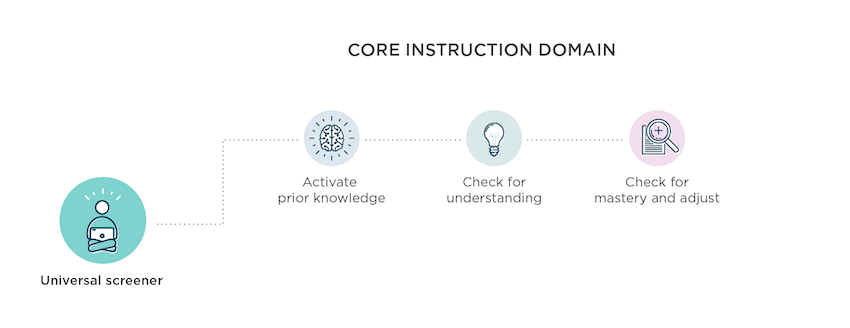
Before core instruction: Activate prior knowledge
Lessons and units should start with formative assessment practices in the form of a pre-assessment or a process of activating prior knowledge. This serves the purpose of illustrating what students already know and assists teachers and students in understanding the learning path that students will need to take to reach the learning target.
Formative assessment at the beginning of a lesson or unit can take many forms, such as entrance tickets, K-W-L chart activities, Venn diagrams, think-pair-share, and more. No matter the type, a formative assessment activity at the beginning of a lesson or unit will create the context for helping you know how to adapt core instruction by adding more scaffolding for students who may struggle; adapting content to adjust for key background knowledge that the whole class may need to be successful; or developing differentiated paths for advanced students who may wish to go deeper with their learning in the particular content area.
During core instruction: Check for understanding
Formative assessment practices should take the form of checking for understanding. In a lesson, for example, this may occur when you monitor small group conversations, review students’ quick writing assignments, or listen to how students report out on jigsaw activities. Over the course of a unit, formative assessment should be occurring throughout, even incorporating more formal interim assessments, quizzes, and longer-term assignments.
All students should experience teaching and learning that supports their success in the core instruction domain.
What makes these practices formative is using them to adjust instruction to keep learning progressing. If the activities are used for grading or there’s no change to the long-term instructional trajectory, they no longer serve a formative purpose and swing over into the arena of summative assessment.
After core instruction: Check for mastery and adjust
At the end of a lesson or unit, a balanced assessment system will make use of purposeful summative assessment. If the learning targets were clear from the beginning, a summative assessment will focus solely on the success criteria by which students demonstrate that they have learned what was expected. It is often common practice that end-of-unit summative assessments do not serve a formative purpose. However, if you intend to reteach the content or proceed to a new unit that builds on the previous one, summative assessment can be utilized in a formative manner if there is an intentional effort made to adjust teaching and learning based on the degree to which students mastered the success criteria.
Tackling the intervention domain
In the intervention domain, assessment practices often take on different terminology and more formal designs, but they represent similar ideas to the core instruction domain and are guided by the principles of formative assessment. When students are identified by a universal screener as being at risk, adopt the MTSS sequence illustrated below: diagnose learning needs; monitor progress; and check for mastery and adjust.
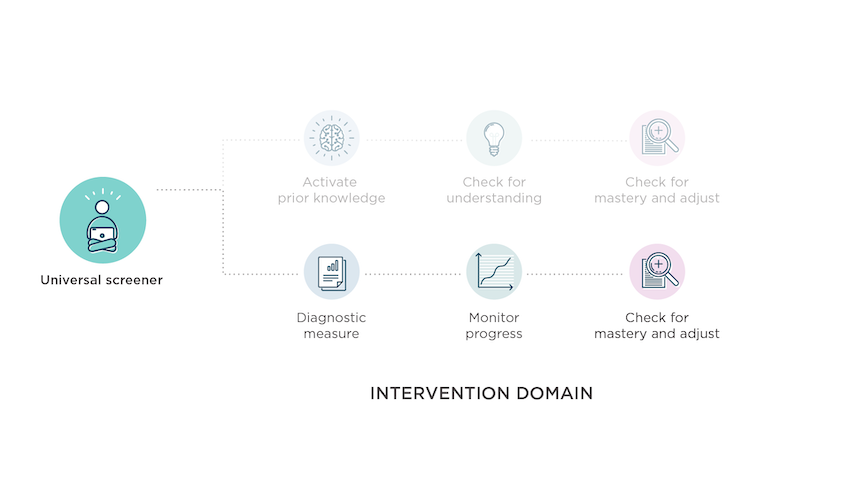
Before intervention: Diagnose learning needs
In elementary schools, educators often make the mistake of making intervention about the content of the universal screener. For example, an early literacy screener might emphasize reading fluency, so some teachers will make intervention about fluency. Without diagnosis, the teacher may not uncover that the root cause of the student’s poor fluency performance is an underlying issue with phonics.
By implementing a clear plan for diagnosis before intervening, you stay true to the idea of formative assessment by gaining the information you need to pinpoint the best starting point for teaching and learning. In early literacy, there are diagnostic assessments for phonemic awareness, phonics, comprehension, and more. In high school, a mathematics teacher may engage in diagnostic assessment by assessing students on a spectrum of math standards from lower grade levels. Regardless, the purpose of diagnostic assessment has the long-term learning trajectory in mind and can be matched with short-term success criteria that students can demonstrate to show their learning is on track. This creates the connection between diagnostic assessments and progress monitoring.
During intervention: Monitor progress
Once you pinpoint the entry level for intervention, instruction and a progress-monitoring plan are needed. For example, an eighth-grade algebra teacher may diagnose that a student has strengths in many areas but is struggling because they have not yet learned to identify when two expressions are equivalent (a sixth-grade standard). This means that during intervention, instruction would begin at this level, and a learning path would slowly build toward eighth-grade standards. Formative assessment would occur in the form of progress monitoring that is broken out to measure the success criteria of each step needed to meet the related eighth-grade math standards.
Similarly, in early literacy, when students have mastered their basic phonics skills but still need support working on automaticity, accuracy, and prosody (i.e., fluency), a teacher might choose to use the progress monitoring for oral reading test within MAP Reading Fluency as a progress-monitoring tool.
By implementing a clear plan for diagnosis before intervening, you stay true to the idea of formative assessment by gaining the information you need to pinpoint the best starting point for teaching and learning.
Similarly, in early literacy, if a third-grade student is identified as struggling with variant vowels (a first-grade skill), intervention would build from variant vowels and measure student progress toward mastery of this and successive phonics skills until the student demonstrates grade-appropriate success criteria with word reading.
After intervention: Check for mastery and adjust
Following instruction, student learning should be verified through a summative assessment that measures whether or not a student has mastered the goals that have been set within their learning progression. A summative approach could even be the same diagnostic assessment tool that was used to identify the student’s learning needs. If this is the case, the purpose changes from a formative, diagnostic use to a summative checkpoint that assesses mastery.
Tying it all together
Here’s a visual representation of the sequence and relationship between formative, interim, and summative assessment and the relevant assessment approaches that are most helpful in the core instruction domain and the intervention domain.
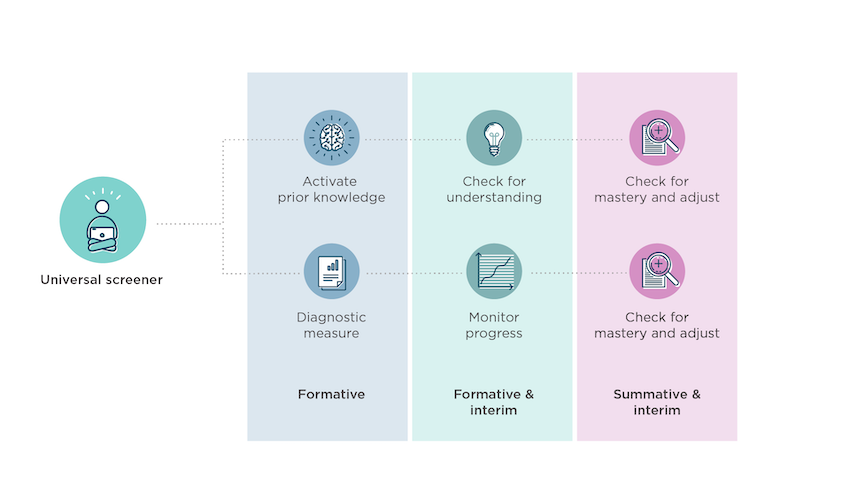
Want to be sure you’re engaging in formative assessment every step of the way? Here’s how:
- Use the information you glean about students before instruction to plan core instruction and intervention
- Take what you learn during instruction to respond to students’ needs and adjust what comes next in your lesson or unit plans
- Put summative assessment gathered after instruction to use guiding how you will reteach content or adjust your plans for the next unit
To explore this topic further—on your own or with your colleagues—try the following discussion questions:
Questions for teachers
- What are ways to activate learning in your classroom?
- During core instruction, how are you checking for understanding during the lesson?
- How does instruction in the domain of intervention differ from the domain of core instruction?
- How can you ensure your classroom has a balanced assessment system in place? In what ways do all of your assessment practices inform each other?
- How have you determined the progression of learning that your students need?
- How are you diagnosing or pinpointing student intervention needs within a learning progression?
Questions for leaders
- What processes do you have in place to monitor school-wide data and reflect on improvements that are needed for teaching, learning, and leading?
- How can you ensure there is a balanced assessment system in place system-wide? To what extent does your school have a systematic approach where different types of assessments inform each other?
- How can you support teachers in identifying effective learning progressions and developing responsive plans that move students forward along a progression?
- Does your school’s schedule assure there is sufficient time for both core instruction and intervention?
This is the third in a series on formative assessment. Read the previous post. And read the entire series in our e-book.









